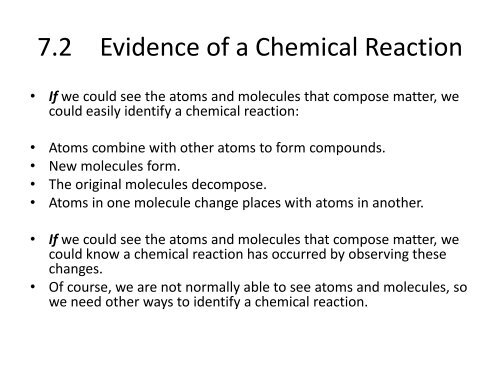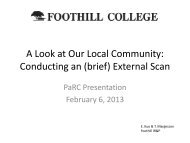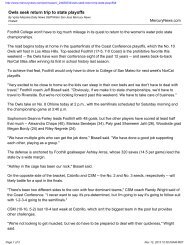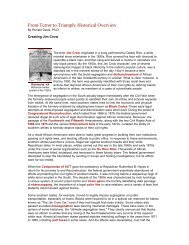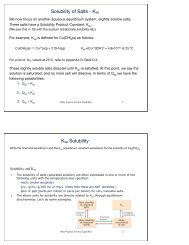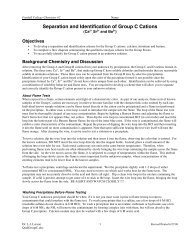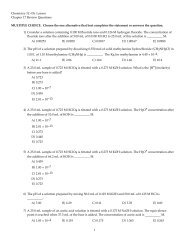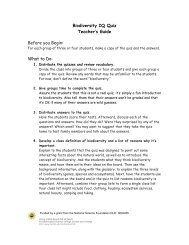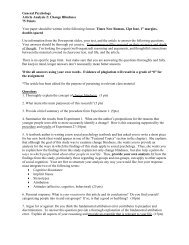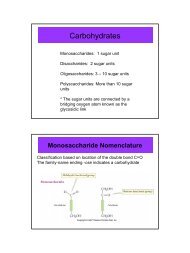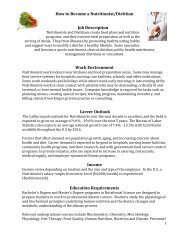7.2 Evidence of a Chemical Reaction
7.2 Evidence of a Chemical Reaction
7.2 Evidence of a Chemical Reaction
You also want an ePaper? Increase the reach of your titles
YUMPU automatically turns print PDFs into web optimized ePapers that Google loves.
<strong>7.2</strong> <strong>Evidence</strong> <strong>of</strong> a <strong>Chemical</strong> <strong>Reaction</strong><br />
• If we could see the atoms and molecules that compose matter, we<br />
could easily identify a chemical reaction:<br />
• Atoms combine with other atoms to form compounds.<br />
• New molecules form.<br />
• The original molecules decompose.<br />
• Atoms in one molecule change places with atoms in another.<br />
• If we could see the atoms and molecules that compose matter, we<br />
could know a chemical reaction has occurred by observing these<br />
changes.<br />
• Of course, we are not normally able to see atoms and molecules, so<br />
we need other ways to identify a chemical reaction.
<strong>7.2</strong> <strong>Evidence</strong> <strong>of</strong> a <strong>Chemical</strong> <strong>Reaction</strong><br />
• The molecules<br />
embedded in the plastic<br />
<strong>of</strong> a child’s<br />
temperature-sensitive<br />
spoon transform upon<br />
warming, and the color<br />
<strong>of</strong> the spoon changes.<br />
• Color changes are<br />
evidence that a<br />
chemical reaction has<br />
occurred.
<strong>7.2</strong> <strong>Evidence</strong> <strong>of</strong> a <strong>Chemical</strong> <strong>Reaction</strong>:<br />
Changes occurring at the atomic and<br />
molecular level determine whether a<br />
chemical reaction has occurred.<br />
• Only chemical analysis that shows that the initial<br />
substances have changed into other substances<br />
conclusively proves that a chemical reaction has<br />
occurred.<br />
• <strong>Chemical</strong> reactions may occur without any<br />
obvious signs, yet chemical analysis may show<br />
that a reaction has indeed occurred.
7.3 The <strong>Chemical</strong> Equation<br />
• We represent chemical reactions with chemical<br />
equations.<br />
• The substances on the left side <strong>of</strong> the equation<br />
are the reactants, and the substances on the<br />
right side are the products.<br />
• We <strong>of</strong>ten specify the state <strong>of</strong> each reactant or<br />
product in parentheses next to the formula.
7.3 The <strong>Chemical</strong> Equation: Combustion<br />
<strong>of</strong> Methane<br />
• The reaction occurring in a natural gas flame is<br />
methane (CH 4) reacting with oxygen (O 2) to form<br />
carbon dioxide (CO 2) and water (H 2O).<br />
• We represent this reaction with the equation:<br />
• With states included, the equation becomes:
7.3 The <strong>Chemical</strong> Equation: Combustion <strong>of</strong> Methane<br />
• How many oxygen atoms are on each side <strong>of</strong> the equation?<br />
The left side <strong>of</strong> the equation has two oxygen atoms and the right side has three.<br />
Atoms cannot simply appear or disappear in chemical equations. We must<br />
account for the atoms on both sides <strong>of</strong> the equation.
7.3 The <strong>Chemical</strong> Equation: Combustion <strong>of</strong> Methane<br />
Notice also that the left side <strong>of</strong> the equation has four hydrogen atoms and the<br />
right side only two.<br />
To correct these problems, we must create a balanced equation.
Checking the Balanced Equation<br />
• The number <strong>of</strong> a particular type <strong>of</strong> atom within a chemical<br />
formula embedded in an equation is obtained by multiplying the<br />
subscript for the atom by the coefficient for the chemical<br />
formula.<br />
• If there is no coefficient or subscript, a 1 is implied.<br />
• The balanced equation for the combustion <strong>of</strong> natural gas is:
7.4 How to Write Balanced <strong>Chemical</strong> Equations<br />
1. Write a skeletal equation by writing correct<br />
chemical formulas for each <strong>of</strong> the reactants<br />
and products. Review Chapter 5 for<br />
nomenclature rules. (If a skeletal equation is<br />
provided, skip this step and go to Step 2.)<br />
2. If an element occurs in only one compound<br />
on both sides <strong>of</strong> the equation, balance it first.<br />
If there is more than one such element,<br />
balance metals before nonmetals.
7.4 How to Write Balanced <strong>Chemical</strong> Equations<br />
3. If an element occurs as a free element on<br />
either side <strong>of</strong> the chemical equation, balance<br />
it last. Always balance free elements by<br />
adjusting the coefficient on the free element.<br />
4. If the balanced equation contains coefficient<br />
fractions, change these into whole numbers<br />
by multiplying the entire equation by the<br />
appropriate factor.
7.4 How to Write Balanced <strong>Chemical</strong> Equations<br />
5. Check to make certain the equation is<br />
balanced by summing the total number <strong>of</strong><br />
each type <strong>of</strong> atom on both sides <strong>of</strong> the<br />
equation.<br />
• Remember, change only the coefficients to<br />
balance a chemical equation; never change<br />
the subscripts.
Example: Write a balanced equation for the reaction <strong>of</strong><br />
solid aluminum with aqueous sulfuric acid to form aqueous<br />
aluminum sulfate and hydrogen gas.<br />
• Use your knowledge <strong>of</strong> chemical nomenclature from<br />
Chapter 5 to write a skeletal equation containing formulas<br />
for each <strong>of</strong> the reactants and products.<br />
• The formulas for each compound MUST BE CORRECT<br />
before you begin to balance the equation.
Example: The reaction <strong>of</strong> solid aluminum with aqueous sulfuric acid<br />
to form aqueous aluminum sulfate and hydrogen gas.<br />
• Since both aluminum and hydrogen occur as pure elements, balance<br />
those last.<br />
• Sulfur and oxygen occur in only one compound on each side <strong>of</strong> the<br />
equation, so balance these first.<br />
• Sulfur and oxygen are part <strong>of</strong> a polyatomic ion that stays intact on<br />
both sides <strong>of</strong> the equation.<br />
• Balance polyatomic ions such as these as a unit.<br />
• There are 3 SO 4 2- ions on the right side <strong>of</strong> the equation, so put a 3 in<br />
front <strong>of</strong> H 2SO 4.
Example: The reaction <strong>of</strong> solid aluminum with aqueous sulfuric acid to<br />
form aqueous aluminum sulfate and hydrogen gas.<br />
• Sum the number <strong>of</strong> atoms on each side to<br />
make sure that the equation is balanced.
7.5 Aqueous Solutions and Solubility:<br />
Compounds Dissolved in Water<br />
• A compound is soluble in a particular liquid if<br />
it dissolves in that liquid.<br />
• A compound is insoluble if it does not dissolve<br />
in the liquid.<br />
• An aqueous solution is a homogeneous<br />
mixture <strong>of</strong> a substance with water.<br />
• When ionic compounds dissolve in water, they<br />
usually dissociate into their component ions.
7.5 Aqueous Solutions: NaCl Dissolves in Water<br />
• A sodium chloride<br />
solution, NaCl(aq), does<br />
not contain any NaCl<br />
units.<br />
• Only dissolved Na + ions<br />
and Cl − ions are present.<br />
• Substances (such as<br />
NaCl) that completely<br />
dissociate into ions in<br />
solution are called<br />
strong electrolytes.
FIGURE 7.6 Ions as conductors<br />
Strong Electrolyte Solutions<br />
(a) Pure water does not<br />
conduct electricity.<br />
(b) Ions in a sodium<br />
chloride solution<br />
conduct electricity,<br />
causing the bulb to<br />
light.<br />
• Solutions such as<br />
NaCl(aq) are called<br />
strong electrolyte<br />
solutions.
Solubility<br />
• For ionic compounds, empirical rules <strong>of</strong><br />
solubility have been deduced from<br />
observations <strong>of</strong> many compounds.<br />
• These solubility rules are summarized in Table<br />
<strong>7.2</strong> and Figure 7.7.
Solubility: Mostly Insoluble<br />
• For example:<br />
• The solubility rules state that, with some exceptions,<br />
compounds containing the CO 3 2− ion are insoluble.<br />
• Compounds such as CaCO 3, FeCO 3, SrCO 3, and CuCO 3<br />
do not dissolve in water.<br />
• Note that the solubility rules contain many exceptions.<br />
• For example, compounds containing CO 3 2− are soluble<br />
when paired with Li + , Na + , K + or NH 4 + .<br />
• Thus Li 2CO 3, Na 2CO 3, K 2CO 3, and (NH 4) 2CO 3 are soluble.
TABLE <strong>7.2</strong> Solubility Rules<br />
After correction is made (PO 4 3 minus)
7.6 Precipitation <strong>Reaction</strong>s: <strong>Reaction</strong>s in<br />
Aqueous Solution That Form a Solid<br />
• Sodium carbonate in laundry detergent reacts<br />
with dissolved Mg 2+ and Ca 2+ ions to form solids<br />
that precipitate from solution.<br />
• These reactions are examples <strong>of</strong> precipitation<br />
reactions, reactions that form a solid (s), called a<br />
precipitate, upon mixing two aqueous solutions.
Predicting Precipitation <strong>Reaction</strong>s<br />
• The key to predicting precipitation reactions is<br />
understanding that only insoluble compounds<br />
form precipitates.<br />
• In a precipitation reaction, two solutions<br />
containing soluble compounds combine and<br />
an insoluble compound precipitates.
2KI(aq) + Pb(NO 3) 2(aq) PbI 2(s) + 2 KNO 3(aq)<br />
• The instant that the solutions are mixed, all four ions<br />
are present.
2KI(aq) + Pb(NO 3) 2(aq) PbI 2(s) + 2 KNO 3(aq)<br />
• The cation from one compound can now pair with the anion<br />
from the other compound to form new (and potentially<br />
insoluble) products.<br />
If the potentially insoluble products are both soluble,<br />
then no reaction occurs.<br />
If one or both <strong>of</strong> the potentially insoluble products are insoluble, a precipitation<br />
reaction occurs.
2KI(aq) + Pb(NO 3) 2(aq) PbI 2(s) + 2 KNO 3(aq)<br />
• In this case, KNO 3is soluble, but PbI 2 is<br />
insoluble. Consequently, PbI 2 precipitates.
Writing Equations for Precipitation <strong>Reaction</strong>s<br />
1. Write an equation for the precipitation reaction that occurs (if<br />
any) when solutions <strong>of</strong> sodium carbonate Na 2CO 3(aq) and<br />
copper(II) chloride CuCl 2(aq) are mixed.<br />
2. Combine the cation from one reactant with the anion from<br />
the other.
Writing Equations for Precipitation <strong>Reaction</strong>s<br />
• Make sure to write correct (charge neutral) formulas<br />
for the new ionic compounds.<br />
3. Use the solubility rules to determine whether any <strong>of</strong> the<br />
potential new products are indeed insoluble.<br />
Potentially Insoluble Products:<br />
NaCl CuCO 3<br />
• NaCl is soluble (compounds containing Cl − are usually<br />
soluble and Na + is not an exception).<br />
• CuCO 3 is insoluble (compounds containing CO 3 2− are<br />
usually insoluble and Cu 2+ is not an exception).
Writing Equations for Precipitation <strong>Reaction</strong>s<br />
4. If all <strong>of</strong> the potentially insoluble products are<br />
soluble, there will be no precipitate. Write NO<br />
REACTION next to the arrow.<br />
5. One <strong>of</strong> the potentially insoluble products is<br />
insoluble, so write its formula as the product<br />
<strong>of</strong> the reaction, using (s) to indicate solid.<br />
Write the soluble product with (aq) to indicate<br />
aqueous.<br />
• Na 2CO 3(aq) + CuCl 2(aq) CuCO 3(s) +<br />
NaCl(aq)
Writing Equations for Precipitation <strong>Reaction</strong>s<br />
6. Balance the equation.<br />
• Remember to adjust only the coefficients, not the<br />
subscripts.<br />
Na 2CO 3(aq) + CuCl 2(aq) CuCO 3(s) + 2NaCl(aq)
7.7 Writing <strong>Chemical</strong> Equations for <strong>Reaction</strong>s in Solution:<br />
Molecular and Complete Ionic Equations<br />
• A molecular equation is an equation showing the complete<br />
neutral formulas for every compound in the reaction.<br />
• Complete ionic equations show aqueous ionic compounds<br />
that normally dissociate in solution as they are actually<br />
present in solution.<br />
• When writing complete ionic equations, separate only<br />
aqueous ionic compounds into their constituent ions.<br />
• Do NOT separate solid, liquid, or gaseous compounds.
7.7 Writing <strong>Chemical</strong> Equations for <strong>Reaction</strong>s in Solution:<br />
Complete Ionic and Net Ionic Equations<br />
• In the complete ionic equation, some <strong>of</strong> the ions in<br />
solution appear unchanged on both sides <strong>of</strong> the<br />
equation.<br />
• These ions are called spectator ions because they<br />
do not participate in the reaction.
7.7 Writing <strong>Chemical</strong> Equations for <strong>Reaction</strong>s in Solution:<br />
Complete Ionic and Net Ionic Equations<br />
• To simplify the equation, and to more clearly<br />
show what is happening, spectator ions can be<br />
omitted.<br />
• Equations such as this one, which show only the<br />
species that actually participate in the reaction,<br />
are called net ionic equations.<br />
Ag + (aq) + Cl − (aq) AgCl(s)
Molecular, Complete Ionic, and Net Ionic<br />
Equations<br />
To summarize:<br />
A molecular equation is a chemical equation<br />
showing the complete, neutral formulas for every<br />
compound in a reaction.<br />
A complete ionic equation is a chemical equation<br />
showing all <strong>of</strong> the species as they are actually<br />
present in solution.<br />
A net ionic equation is an equation showing only<br />
the species that actually participate in the<br />
reaction.
7.8 Acid–Base <strong>Reaction</strong>s<br />
• Acid–base reactions are reactions that form<br />
water upon mixing <strong>of</strong> an acid and a base.
• Acid–base reactions<br />
7.8 Acid–Base <strong>Reaction</strong>s<br />
(also called neutralization reactions)<br />
generally form water and an ionic<br />
compound—called a salt—that usually<br />
remains dissolved in the solution.<br />
The net ionic equation for many acid–base<br />
reactions is:<br />
H + (aq) + OH − (aq) H 2O(l)
7.8 Acid–Base <strong>Reaction</strong>s:<br />
Some Common Acids and Bases
7.8 Gas Evolution <strong>Reaction</strong>s
7.9 Oxidation–Reduction <strong>Reaction</strong>s<br />
• <strong>Reaction</strong>s involving the transfer <strong>of</strong> electrons<br />
are called oxidation–reduction reactions or<br />
redox reactions.<br />
• Redox reactions are responsible for the rusting<br />
<strong>of</strong> iron, the bleaching <strong>of</strong> hair, and the<br />
production <strong>of</strong> electricity in batteries.<br />
• Many redox reactions involve the reaction <strong>of</strong> a<br />
substance with oxygen.
7.9 Oxidation–Reduction <strong>Reaction</strong>s<br />
• A fundamental definition <strong>of</strong> oxidation is the loss <strong>of</strong><br />
electrons.<br />
• A fundamental definition <strong>of</strong> reduction is the gain<br />
<strong>of</strong> electrons.<br />
• Helpful mnemonics:<br />
OIL RIG—Oxidation Is Loss; Reduction Is Gain.<br />
LEO GER—Lose Electrons Oxidation; Gain Electrons<br />
Reduction.
7.9 Oxidation–Reduction <strong>Reaction</strong>s<br />
• Notice that oxidation and reduction must<br />
occur together.<br />
• If one substance loses electrons (oxidation),<br />
then another substance must gain electrons<br />
(reduction).<br />
• For now, you simply need to be able to<br />
identify redox reactions.
7.9 Oxidation–Reduction <strong>Reaction</strong>s<br />
• A reaction can be classified as a redox reaction<br />
if it meets any one <strong>of</strong> these requirements.<br />
Redox reactions are those in which:<br />
• A substance reacts with elemental oxygen.<br />
• A metal reacts with a nonmetal.<br />
• More generally, one substance transfers<br />
electrons to another substance.
7.10 Classifying <strong>Chemical</strong> <strong>Reaction</strong>s
7.10 Classifying <strong>Chemical</strong> <strong>Reaction</strong>s by<br />
What Atoms Do


